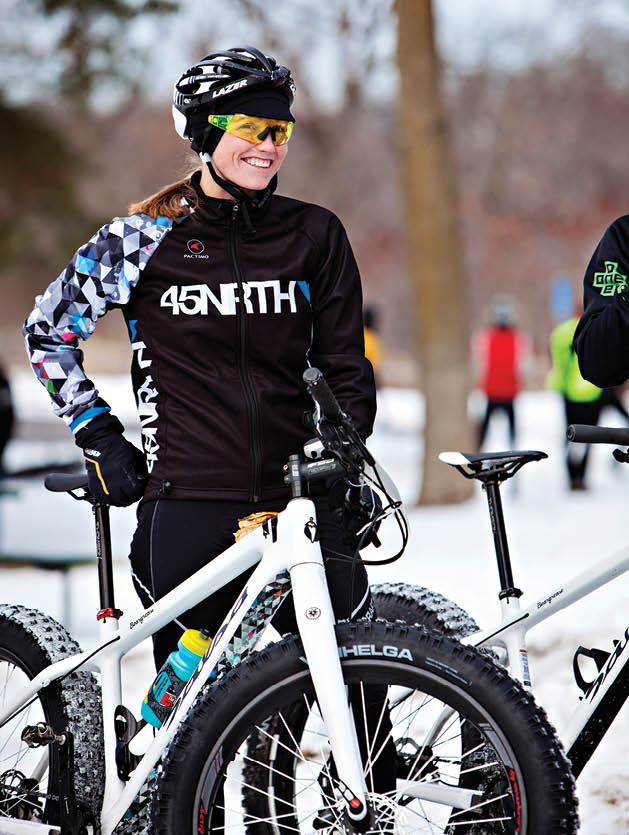Starting temperature: a balmy 22 degrees. The crisp air is thick in my mouth, the slightly metallic taste of blood easily associated with physical exertion in temperatures below freezing stinging my throat and energizing my body as I line up (toward the back of the pack) amid 150 other riders at the start line of the Cold Catfish Cup, my first mountain bike race.
Each count to the start sends another surge of butterflies down from the base of my throat through my gut and finally to my semi-numb appendages; despite two layers of winter riding gloves, long underwear atop my riding shorts and beneath my snow-riding pants and jacket, winter riding boots and a face-masked winter cap beneath my helmet, I know I won’t warm up until I have at least a half-lap (or 2.5 miles) in, but with just brief warmups atop a borrowed Salsa carbon Beargrease, I’m still shivering and winded from the pure adrenaline of race-day anticipation.
A runner by preference, I rode my first mountain bike trail at Battle Creek Park near the western edge of Woodbury about 13 years ago, but when offered the opportunity to ride the 2015 Cold Catfish, I had to jump at the chance. It was an opportunity that would not have been possible even six years ago—for one, fatbikes in the Midwest were almost obsolete at the time, looked upon as a fad that wouldn’t last; and two, Carver Lake’s trails hadn’t even been built yet, but all of that was soon to change.
Mountain Biking in Woodbury
The Minnesota Off-road Cyclists (MORC) mountain bike organization and trail-building group began construction on the 5.5 miles of unpaved, single-track trails at Carver Lake in spring 2010. At the time, Woodbury city recreation specialist Reed Smidt was highly active in the group, helping to build and maintain other mountain bike trails throughout the metro. He’s an avid mountain biker who first rode dirt in 1993, he says. “I just happened to be a mountain biker who built trails who worked for the city,” Smidt says of his role in creating Carver Lake’s rolling hills and thick wooded switchback trail system.
Considered an intermediate course in the summer, with several short expert-level optional sections, the addition of snow actually evens out the playing field a bit, provided the snow is well-packed with a solid base that’s not too deep or otherwise churned up. The trail, which opened in July 2011, is open 6 a.m. to 10 p.m., technically year-round, with closures for wet trail conditions especially during the spring and fall thaw/freeze periods. It opens for the winter once there’s a solid base of frozen ground or snow, which is primarily groomed and maintained by the snowshoers who share the system in winter.
That same year, the owner of Minneapolis’s Angry Catfish Bike Shop, Josh Klauck, contacted Smidt with an interest in Carver Lake’s new trails and in partnering for a race. “Every winter rolls around, and we see a huge jump in [fatbike] participation, involvement from cyclists and outdoor enthusiasts of all types,” says Parker Roenfanz, shop manager for Angry Catfish. “When we saw the demand growing, we thought it would be fun to put on a little race. Carver Lake Park and its mountain bike trails were some of the first, if not the first, set of trails professionally groomed for winter riding in the area. We’ve always liked the trail system at Carver because it allows for shorter loops with better spectating.”
At the time, there weren’t a lot of winter races in the metro. Shy of one in Elk River and The Frozen 40 at Elm Creek Park Reserve, the Cold Catfish was among the first three, but since then the trend has exploded, allowing for a serious rider to be able to find a race almost any given winter weekend around the metro.
Much like mountain-bike racing, fatbike races are pretty simple to organize: You don’t have to close roads or pull massive permits, and it’s all contained within a somewhat small area, Roenfanz says. “A fat race works best with the park’s schedule,” Smidt says. “There’s less residential traffic in the park in the winter.”
Since those humble beginnings, the event has grown steadily each year. “We can only accommodate so many on the course,” Smidt says. In 2014 there were 107 racers; last year saw the course limit of 150, and registration closed about a week ahead of time. “Our parking lot just isn’t big enough,” Smidt explains. “We had people parking all the way to Century Avenue, so if you missed out, sign up earlier this year.”
The race distance varies each year depending on weather conditions, but a 15-mile race for advanced riders is ideal (three laps, closer to 10 miles and two laps for intermediate riders). As the course also incorporates the lake itself on good years, it can get as long as 21 miles, allowing for a beginner 7.5-mile course.
“One of the biggest benefits of the Cold Catfish, I think, is that it brings exposure to one of Woodbury’s premier parks,” Smidt says. “Residents don’t even know about it that well ... It’s not a regional park, but it has a regional draw in some ways.” Carver Lake’s proximity to Penn Cycle—and the SuperAmerica next door—isn’t so bad for the local cycling economy, either. And, since the beginning, race organizers have been committed to giving back: All money raised in entry fees goes back into the trail. For the riders’ part, sweet swag like the 2015 45NRTH gear (for the first 75 registered) is well worth the $20 price of admission in and of itself.
“There are not too many communities that have an off-road trail,” Smidt says. “It’s a fun type of trail all year, and it’s nice to be able to offer that.
“The future of fatbiking is extremely promising. We’ve seen such a diverse demographic jump into the fatbike world,” Roenfanz adds. “Because the bikes aren’t that much heavier than normal mountain bikes, they roll pretty dang well, and they inspire confidence over obstacles and rough terrain. They’re bringing new riders into the mountain bike world that have never explored it before.”
A Community of Volunteers
Cold Catfish actually started as a series over the course of three weekends in January 2012; in 2013 it transitioned into the single-day event. Ten to 15 volunteers are needed to pull it off, including registration personnel, race marshals, course marshals and, beginning in 2014, a professional timer.
Woodbury resident Viv Jones, a scientist at 3M by day, is one of the main trail crew leaders at Carver Lake throughout the year, and he’s volunteered at the Cold Catfish for the past three years. He’s also a husband and father of two teenage daughters, and his entire family rides their Salsa fatbikes regularly on the trails. “I love being outdoors, whizzing around trees and rocks,” he says. “I don’t race; I ride purely for fitness and pleasure,” but the work he does allow others to ride year-round.
Jeff Leech is a MORC trail crew volunteer and head of snow grooming operations. “In winter, we only maintain if it snows 3 inches or more,” he says. “After a big snow, it takes two to three days to groom the trails.” Generally, grooming consists of walking the trail on snowshoes a couple of times, and the more than 5 miles is about a three-hour hike.
Last year, however, MORC acquired a two-wheel adapted motorcycle to help pack the trails. “MORC purchased it after seeing the success Elm Creek had with a similar motorbike, and we found an outfit in St. Cloud that agreed to modify it for use at Carver Lake,” Leech says.
The week of the race, the only addition to regular grooming maintenance is the lake, as the race makes use of the frozen water whenever weather permits. “Last year we used the snowmobike to make sure it’s groomed and packed down ahead of the race,” Leech says.
Carver Lake’s Podium
In 2014, Leech did more than volunteer—he raced under very challenging conditions. Temperatures dipped below zero almost every day of the month, and near-record snowfalls made it impossible to create a well-packed base, which meant the trail got very churned up with old, chunky snow during the course of the event. “My pace is generally slow and steady; I enter just to finish. My max speed is 5 to 6 mph,” Leech says. “But it seems with all of these kinds of fatbike events, the harder the race, the better the racers like it.”
And Woodbury can be proud of its setting for the Cold Catfish Cup. “The course is a riot; Carver Lake always has a really fun set of trails to ride in the winter,” Roenfanz says. “We always try and incorporate new and fun features into it every year, so you never know what Reed and the trail crew is going to carve out of the snow.”
Along with the terrain, the greatest part about the race is the people who show up, says Rowan Vans. “It’s amazing to see such a great mix of diehard riders, weekend warriors, and novice riders come out and spin those big tires through the snow.” Smidt suggests the hill leading down to the lake as the best spot to spectate; Leech goes even further down to the lake, “because you can see the riders all around the lake and as they climb the first section of single track through the trees.”
A Perfect Day to Ride
The 2015 Cold Catfish is memorable not just for the fact that it is my first race, one I proudly and humbly compete in just less than an hour. The conditions prove perfect for a very fast race.
As I rode, I noticed the churning of the snow into a fine powder—slick, but much more manageable because it is fresh on a well-packed base trail. Very few spots were icy; most of the trail had a crisp crunch to it from recent warm temps (hovering closer to freezing than zero) and the convenient 2-inch dusting we’d received two days before the race.
But ultimately the design of Carver Lake’s trail makes this race accessible to riders of all levels. “The course is groomed enough that the really competitive riders can pound it,” Leech says. “But you’d be surprised—[most of the participants are] out here to ride the advanced, three-lap course, just for the heck of it—just to say they finished.”
The History of Fat
Sources: Adventure
Cycling Association and Quality Bicycle Products
Fatbikes are named
for the width of their tires, a heftier 3.5 to 5 inches that resembles
something closer to a motorbike than a cycle. They are designed for one primary
purpose: better flotation on snow or on sand. As mountain bikes became popular
in the 1980s, customizations for riding these conditions were quick to follow,
and in 1987 when the first IDI took place (Iditarod Invitational in Alaska,
along some of the same dog-mushing trails made famous by those events since the
turn of the 20th century), the need for a bike that riders could actually stay
on top of through the harshest conditions was born. A wider tire footprint was
the key.
Simon Rakower of
Fairbanks, Alaska, modified standard rims such that they could be laced in
tandem with a single hub but two tires. Another experiment, called the
Six-pack, included tying three wheels together in both front and back for
maximum traction. At about the same time, Ray Molina—commonly referred to as
the grandfather of fat—was riding sand dunes and arroyos in New Mexico, and
began manufacturing an 82mm-wide rim across the border in Mexico, along with a
3.5-inch tire to match. He made several frames to accommodate the new equipment.
At the Interbike trade show in Las Vegas in late 1999, Alaskan Mark Groneweld
made plans to bring Remolino rims to Alaska. Paired with his custom Wildfire
Designs frame and a 3.0-inch to 3.5-inch tire, the first modern fatbikes were
born.
In 2005, the Surly
Pugsley provided the single greatest boost to availability and participation in
the history of the fatbike by making them accessible. Original purple Pugsleys
were available to almost any bike shop in the country through Quality Bicycle
Parts (QBP), a Bloomington, Minn.-based distributor with broad reach. Several
other companies quickly joined the market: In 2007, pioneering a symmetrical
aluminum frame with ultra-wide hubs and rims, the Fatback bike company of
Anchorage, Alaska, pushed fatbikes into the future, providing more flotation
with less weight, and in 2010, both Surly and Salsa released complete fatbikes
through the QBP distribution chain that included even lighter frames in carbon
versions (Surly and Salsa are locally based companies, too).
Perhaps the latest
advancement in recent years is the addition of the Bucksaw to the Salsa fatbike
line in 2014; specifically engineered with traction in mind, only 4-inch tires
are recommended, making this the mountain-biker’s fatbike and optimizing
desert-like conditions where there’s a mix of rough single-track and buoyant
sand. Today, a dozen companies are offering complete fatbikes.

Fifth Annual Cold Catfish Cup
Sponsored by Angry Catfish Bike Shop and Coffee Bar
January 24, noon–5 p.m.; check-in begins at 9:30 a.m. (All participants must be registered in advance.) First race begins at 11 a.m.
$20 per participant
Carver Lake Trails, 3175 Century Ave. S.
Where to Watch:
- The hill on the northwest side of the parking lot leading down to the lake: this allows great vantage for the steepest, longest climb of the race coming back up from the lake.
- The lake itself, near the beach: see the entire lake and the south single-track riders in the distance.
- The area of single track to the south of the parking lot: a good example of the gorgeous, wooded terrain the riders get to experience the majority of the race, at a glance.
- The area of single track to the east of the parking lot: great switchback and some of the steepest descents of the course.









